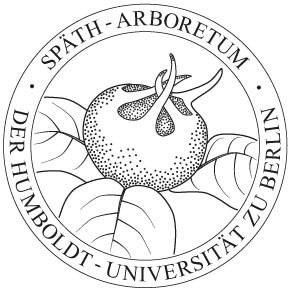The medlar in the logo of Späth-Arboretum
With the transfer of the Arboretum to the Humboldt University of Berlin in 1961, the medlar was chosen as the symbol plant of the institution. Whether there were other reasons for this choice besides the attractiveness of this native tree has not been passed down. Since then, the medlar logo has adorned publications (books, leaflets, commemorative publications) from the Späth-Arboretum and also a plaque made of Böttger stoneware issued to mark the 100th anniversary of the Arboretum in 1979. The logo existed in different versions. It has been in its current form since the end of 2014.

The German medlar (Mespilus germanica L.) - not to be confused with the hemiparasitic mistletoe growing on other trees - is an old fruit tree of the rose family (Rosaceae). Contrary to what its name suggests, the medlar comes from the area of present-day Iraq. It came to us via Asia Minor and Greece in the luggage of Roman legionnaires. And it would have been forgotten if it had not survived for a long time in German monastery gardens and had been used there. This is where the name German medlar comes from, even though today it is cultivated more strongly in the Balkan and Danube countries as well as Italy and Holland.
The genus medlar (Mespilus) comprises only one species. It is closely related to the genera Eriobotrya (loquat), Cotoneaster (dwarf medlar), Amelanchier (shadbush) and Crataegus (hawthorn).
The medlar is a broadly spreading shrub or small tree up to 6 m high. The young twigs are tomentose. The leaves of the deciduous tree are alternate, short stalked and 7-12 cm long, serrate or with almost entire margins. The white flowers have a diameter of up to 5 cm. There are 30 to 40 stamens in annular arrangement and with pink anthers. The flower is almost sessile and does not smell. Due to the late flowering in May/June the medlar is hardly endangered by late frosts. The medlar is self-fertile. The fruits are brown, top-shaped, similar to a flattened rose hip of about 4 cm in diameter and with very conspicuous long calyx tips. The old popular names "Hundsärsch" ("Dog's Ass") or "Apenars" allude to the unusual fruit shape. Botanically the medlar is a aggregate drupe with 5 drupelets, each with a solid pit.

The fruits are only edible after the first frost. They also ripen when in storage after harvest. The fruits can be processed into jam, juice and liqueur, serve to enhance fruit wine, are marinated in honey or vinegar. They are dried and ground and baked.
An astringent effect is described in old herbal books for bark, leaves and unripe fruits. Parts of plants or extracts are supposed to stop bleeding, were used against kidney stones, throat complaints and to regulate intestinal activity; the latter presumably because of the very high pectin content of the fruits.
The wood of the medlar is yellowish brown and heavy. Because of its hardness it was used for the production of hunting spears and fighting equipment, was used in carpentry, turning and charcoal production.
The slowly growing trees with their white flowers, a beautiful brown-red to dark yellow autumn colouring and the usable fruits turn the medlar into a valuable tree for the garden.
In the Arboretum, in addition to a magnificent and productive specimen on section 25, there are two chimeric or hawthorn-medlars with smaller fruits reminiscent of hawthorn in section 14.
References:
SCHUSTER, R. (1989). Bäume und Sträucher von Abies bis Zelkova - Wissenswertes über Freilandgehölze des Botanischen Gartens der Ernst-Moritz-Arndt-Universität Greifswald, Greifswald
FRIEDRICH, G. und W. SCHURICHT (1985). Seltenes Kern-, Stein- und Beerenobst, Leipzig
VENT, W., D. BENKERT und K.-H. HOEPFNER (1979). Dendrologischer Führer durch das Arboretum des Museums für Naturkunde der Humboldt-Universität zu Berlin, Berlin
VETVICKA, V. (1985). Bäume und Sträucher, Artia-Verlag Praha
